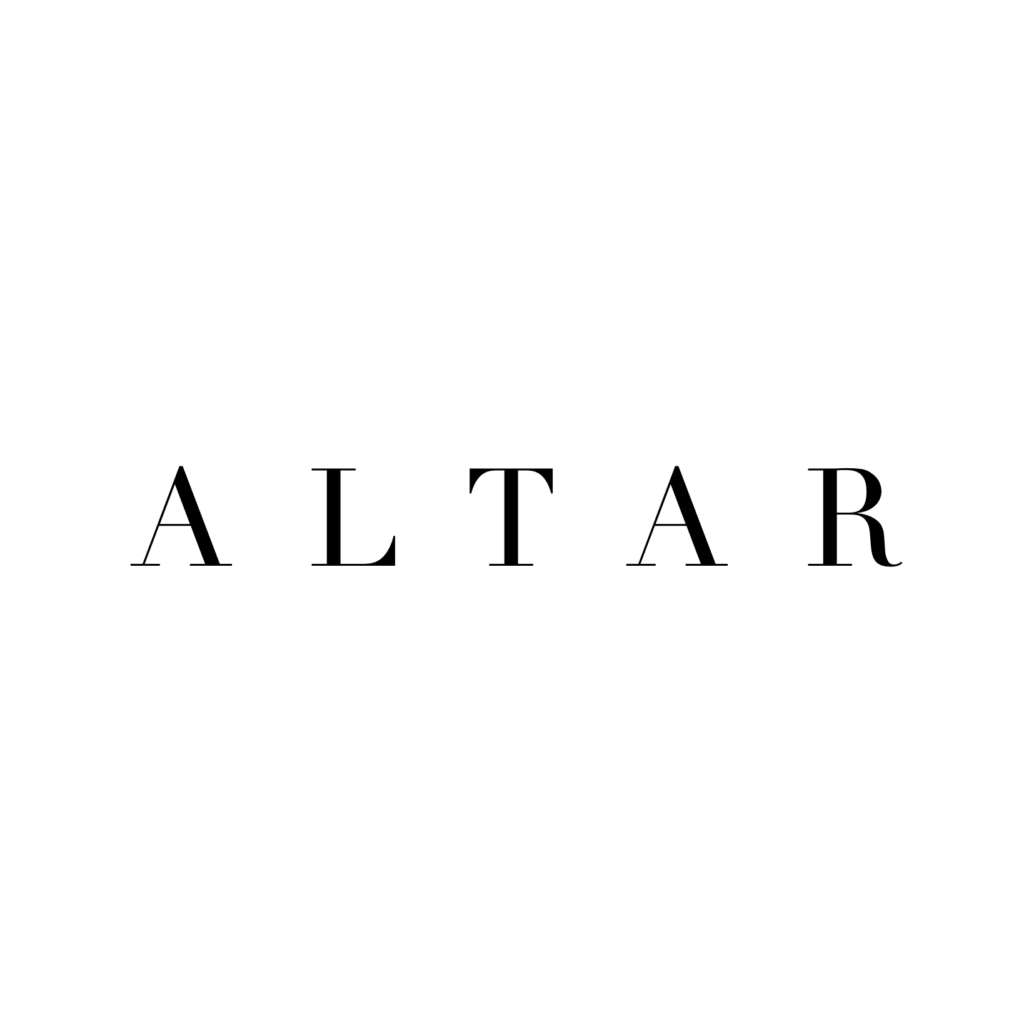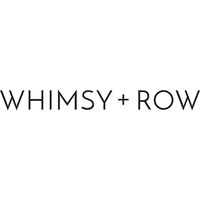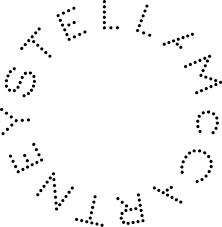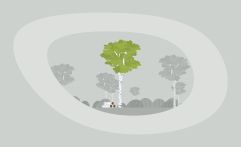13 Most Sustainable Viscose Clothing Brands: The Conscious Consumer’s Guide
Impactful Ninja is reader-supported. When you buy through links on our site, we may earn an affiliate commission.
Learn more
Learn more
.
Hey fellow impactful ninja ? You may have noticed that Impactful Ninja is all about providing helpful information to make a positive impact on the world and society. And that we love to link back to where we found all the information for each of our posts. Most of these links are informational-based for you to check out their primary sources with one click. But some of these links are so-called "affiliate links" to products that we recommend. First and foremost, because we believe that they add value to you. For example, when we wrote a post about the environmental impact of long showers, we came across an EPA recommendation to use WaterSense showerheads. So we linked to where you can find them. Or, for many of our posts, we also link to our favorite books on that topic so that you can get a much more holistic overview than one single blog post could provide. And when there is an affiliate program for these products, we sign up for it. For example, as Amazon Associates, we earn from qualifying purchases. First, and most importantly, we still only recommend products that we believe add value for you. When you buy something through one of our affiliate links, we may earn a small commission - but at no additional costs to you. And when you buy something through a link that is not an affiliate link, we won’t receive any commission but we’ll still be happy to have helped you. When we find products that we believe add value to you and the seller has an affiliate program, we sign up for it. When you buy something through one of our affiliate links, we may earn a small commission (at no extra costs to you). And at this point in time, all money is reinvested in sharing the most helpful content with you. This includes all operating costs for running this site and the content creation itself. You may have noticed by the way Impactful Ninja is operated that money is not the driving factor behind it. It is a passion project of mine and I love to share helpful information with you to make a positive impact on the world and society. However, it's a project in that I invest a lot of time and also quite some money. Eventually, my dream is to one day turn this passion project into my full-time job and provide even more helpful information. But that's still a long time to go. Stay impactful,Affiliate Disclosure
Why do we add these product links?
What do these affiliate links mean for you?
What do these affiliate links mean for us?
What does this mean for me personally?
![]()
The first generation of regenerated cellulose fiber, viscose, was originally developed as an artificial alternative to silk. Conventional viscose manufacturers source plant-based materials yet use energy-demanding and chemically-intensive processes. Furthermore, fashion greenwashing practices often shine the spotlight on the renewable plant materials used to make viscose, making it hard for you and all other consumers to figure out which viscose clothing brands offer the most eco-friendly clothes. So, we had to ask: Which are the most sustainable viscose clothing brands?
The most sustainable viscose clothing brands are Altar, ARMEDANGELS, and Baukjen, which cut down their carbon emissions, employ full traceability, and strive for circularity. In addition, TWOTHIRDS and Encircled minimize waste and adhere to ethical practices.
Whether you are searching for a versatile top, an elegant dress, or some comfortable underwear to add to your wardrobe without negatively impacting the soil, the water, the animals, and other people, there is a brand for you. So, let’s keep reading to learn more about the most sustainable viscose clothing brands and how they ensure sustainable, ethical practices.
Here’s How Sustainable Viscose Fabrics Generally Are
Viscose is the first generation of rayon, semi-synthetic fabrics made with regenerated cellulose fibers and dissolvent chemicals. The viscose process is highly chemical and energy-intensive, reducing the sustainability of this plant-derived material. The Common Objective’s Made-By Environmental Benchmark for Fibres ranked generic viscose class A—the least sustainable category of fibers. However, viscose fibers can be made more sustainably by sourcing raw materials from sustainably managed forests, recovering energy from production, and optimizing manufacturing inputs.
“Sustainable: The ability to be maintained at a certain rate or level | Avoidance of the depletion of natural resources in order to maintain an ecological balance”
Oxford Dictionary
To understand the sustainability of cotton, we’ve assessed the life-cycle and each stage’s sustainability. This life-cycle assessment (LCA) is a method to evaluate the environmental impacts of products and materials. Here’s the quick summary of our LCA of viscose!
What makes sustainable viscose: Lenzing-made viscose ECOVERO™ is generally considered sustainable, thanks to the closed-loop manufacturing process, which recovers and reuses more than 99% of chemicals. Additionally, Lenzing sources plant materials for ECOVERO™ from certified and sustainably managed forests.
Additionally: Upcycled viscose is sustainable as it bypasses the high-impact manufacturing process.
Here’s How We Selected the Most Sustainable Viscose Clothing Brands
The brands on this list were chosen based on their commitment and actions to promote sustainable practices while reducing the environmental impacts of the textile industry.
They are transparent about their materials, processes, and workforce management within their supply chain.
Some brands focus their efforts on reducing waste and optimizing natural resources while others strive to reduce the carbon footprint of their clothes.
All of these brands share the commitment to reshape the textile industry toward a more sustainable and Earth-friendly sector.
These Are the 13 Most Sustainable Viscose Clothing Brands
Most Sustainable Viscose Clothing Brands
Overall, these viscose clothing brands are sustainable. Yet, they take various approaches to reduce environmental impacts and uphold ethical standards. Let’s dive into each brand and find out more.
Altar: Customized US-Made Clothes From Deadstock Fabrics
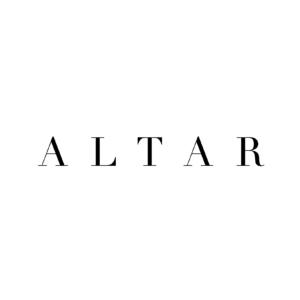
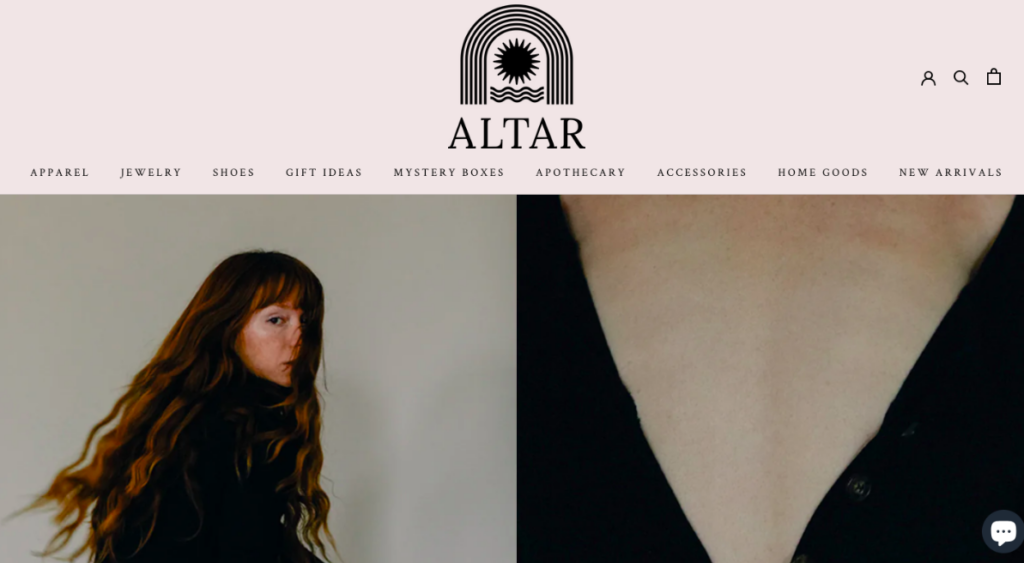
“Our store is committed to diversity and inclusivity: in our hiring practices, our product sourcing, our visual content, and our core values.”
Altar
🌎
How do they ensure their sustainability?
Altar ensures sustainability by sourcing a high proportion of deadstock fabrics, particularly plant-derived fiber families (lyocell, modal, and viscose), for their apparel, taking made-in-order and zero-waste approaches to production to reduce waste, and extending the garment’s life-cycle with their repairing service and their platform selling pre-loved clothes. In addition to using deadstock fabrics, Altar further reduces textile waste by operating small made-to-order runs, making the most of their material while avoiding large inventory. They also utilize their scrap fabric to create small accessories as well as One-Of-A-Kind Zero-Waste garment pieces, keeping textile waste, synthetic fabrics in particular, out of landfills. For unusable scraps, they recycle using ReTold Recycling. Beyond textiles, Altar commits to sustainable sourcing of packaging materials, using compostable mailers, gift boxes, bags, and tissues from Noissue, Packwire, Rio Grande, and Papermart. They also reuse bubble wrap from received orders when necessary. Additionally, their partnership with Treet and Recovo enables closing the circle of waste on both ends of their production. Lastly, Altar produces apparel locally in the US, reducing the transporting carbon footprint.
🌐
How do they ensure their ethics?
Altar traces most of their supply chain, including the final stage of production undertaken in the US. Additionally, they commit to diversity and inclusivity. Their working practices and clothing production represent the diversity of body types, gender, race, and cultural identities. Examples of these ethical practices are the size gradations up to 6XL, increased sourcing from BIPOC (Black, Indigenous, and People Of Color) manufacturers, and an Afterpay option to lessen some barriers to entry on price points.
🤝
Are they part of any giving-back programs?
Altar partners with Greenspark to contribute to environmental projects, including planting trees, collecting plastics, and offsetting carbon emissions. For example, for every purchase made of Altar apparel, they rescue ten plastic bottles from the ocean. They also contribute to various charities, including but not limited to Black Lives Matter, Doctors for Global Health (DGH Foundation), Reclaim the Block, Don’t Shoot PDX, and Palestine Children’s Relief Fund.
🛍️
What is their product range?
- Best for: womenswear
- Product range: dresses, tops, bottoms, sweaters, rompers, swimwear, underwear, shoes, accessories, plus size
- Price range: $$$$
- Size range: S–6XL
ARMEDANGELS: Sustainable Clothing Brand Plus an Agent of Lifestyle Change

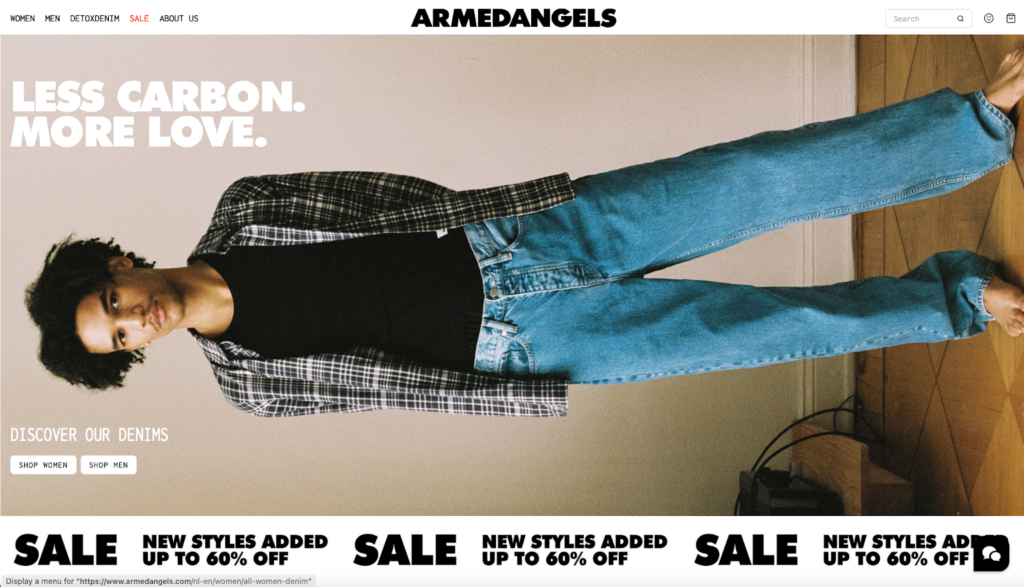
“So starting out with the humble tee, we took our oath against wage slavery, chemical shortcuts, and mass-producing pure crap, and transformed ourselves into one of the first clothing brands in all the land to put people and planet first.”
ARMEDANGELS
🌎
How do they ensure their sustainability?
ARMEDANGELS ensures sustainability by reducing carbon footprints while enabling people to change lifestyles to fight climate change. The brand innovates to cut down carbon emissions in their supply chain, starting with sourcing a high proportion of eco-friendly materials. Specifically, they use GOTS-certified organic cotton fabrics, GRS-certified recycled fabrics, GOTS-and RWS-certified organic wool fabrics, and FSC/PEFC-certified cellulose fabrics like LenzingTM ECOVEROTM. Additionally, ARMEDANGELS chooses materials with the lowest carbon footprint possible, for example, opting for wood-based fabrics over silk or natural fabrics over fossil-based synthetic fabrics while increasing recycled content, such as recycled wool and recycled cotton. For example, within a year, the share of recycled cotton in their DetoxDenim jeans increased from 5% to 37%, with some jeans in the collection containing 100% recycled cotton. Lastly, ARMEDANGELS’s efforts to encourage lifestyle change include care and repair guides to keep garments longer in circulation. They also have a resale platform that facilitates traded-in to be sold again as second-hand clothes or recycled as fibers for new clothes.
🌐
How do they ensure their ethics?
ARMEDANGELS ensures their ethics by only working with trusted partners to deliver decent wages and workers’ safety. They directly and actively monitor all their suppliers and the suppliers’ nominated subcontractors via on-site and online Internal Due Diligence Check and Self-Assessment, external audits by Fair Wear Foundation (FWF), Global Organic Textile Standard and third-party audits, continuous support, and tailored training programs by third parties. ARMEDANGELS ensures payment of a living wage in part of their supply chain and pays a markup where they notice wage issues via the living wage project. Most importantly, they are fully transparent about the journey from raw material to their products, especially where people and animals are involved, and the impacts of their actions.
🤝
Are they part of any giving-back programs?
ARMEDANGELS raises funds by donating part of their sales to support various organizations and campaigns. For example, during the COVID-19 pandemic, they have raised €745.800 ($790,883.61 USD) for Doctors Without Borders, facilitating isolation wards, COVID-19 clinics, and protective clothing for medical professionals worldwide. Other fundraising projects include supporting the climate movement with German Zero and the Climate Emergency Fund, fighting for equality with UN Women, advocating for fair payment and safe working conditions for Bangladeshi garment workers with the National Garment Workers Federation, and rescuing refugees in the Mediterranean Sea with Sea-Watch.
🛍️
What is their product range?
- Best for: kidswear, menswear
- Product range: denim jeans, jackets, jumpsuits, shorts, skirts, T-shirts
- Price range: $$
- Size range: XS–XXL
Baukjen: Womenswear Designed for Circularity and Made Sustainably

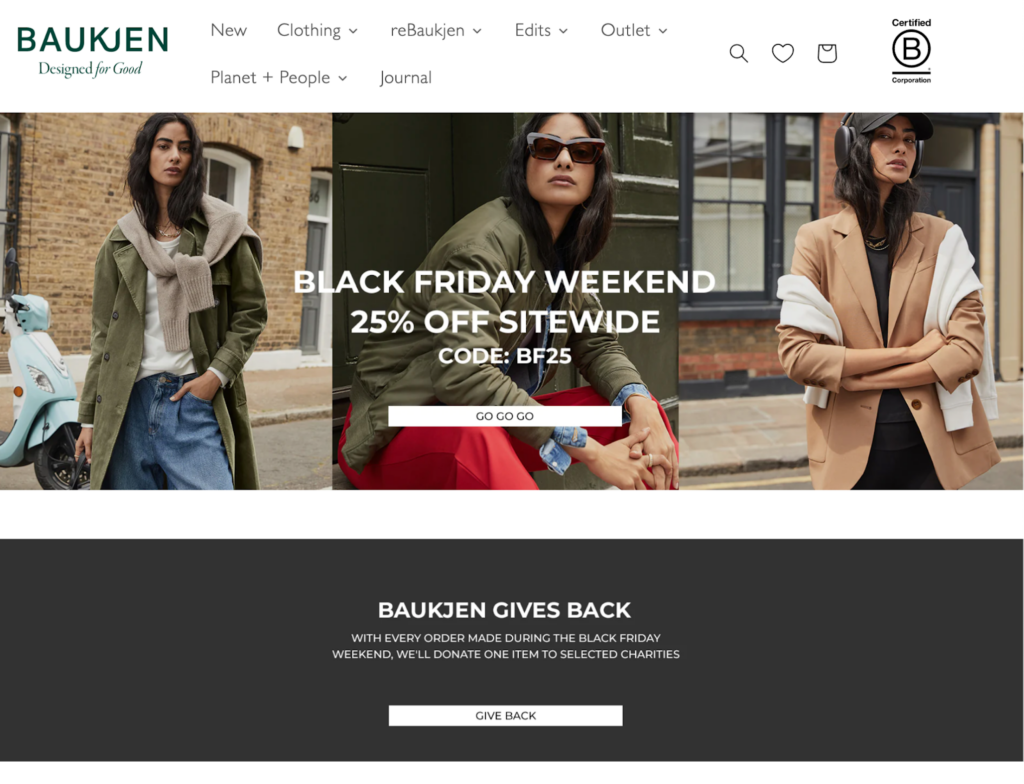
“Our collections are designed for the modern woman struggling with a busy lifestyle. Effortless style is our design signature, premium quality is our standard so our clothes can be worn year after year.”
Baukjen
🌎
How do they ensure their sustainability?
Baukjen ensures sustainability by swapping planet-unfriendly materials for more responsible ones, cutting down impacts throughout their supply chain, and moving towards a circular model. They lower their impact and contribute to a circular materials economy by increasing the proportion of recycled fibers (Ecotec recycled cotton, recycled sheep wool, recycled cashmere, Newlife recycled polyester, recycled down) and regenerative fibers. For example, in the second quarter of 2023, 98.6% of the materials used were from responsible sources with traceable origins, while 98.2% of the fibers used have a proven lower environmental impact. Specifically, their viscose fabrics, which account for 40% of Baukjen and their sister brand Isabelle Oliver’s 2022 collections, are sustainably and ethically sourced, either from Ecojilin viscose, which is made of pre-consumer recycled cotton fibers instead of virgin wood, using significantly less energy and water in the process while avoiding cutting down trees, or from LENZING™ ECOVERO™, Canopy’s top ranking viscose. Further down the life-cycle in the manufacturing stage, they continue to lower the impacts by reducing water usage, using 100% renewable energy in offices and warehouses to decrease their carbon footprint, and minimizing manufacturing waste. For example, the water consumption and carbon emissions in the second quarter of 2023 were 47% and 31% lower than the same quarter in 2020, respectively. Baukjen is also a Zero Waste business, meaning that over 90% of their “waste” is neither landfilled nor incinerated. Once finished, their garments are shipped in 100% plastic-free, recyclable, and biodegradable packaging made from a recycled paper mix certified by FSC or PEFC. Lastly, Baukjen strives towards circularity through their re-commerce initiatives: Pre-Loved, Rental, and Care and Repair.
🌐
How do they ensure their ethics?
Baukjen ensures their ethics by maintaining a high level of transparency regarding their factories and the impacts of their garments. They share the list of their factories, from Tier 1 to Tier 3 suppliers. Their Code of Conduct, signed by all direct suppliers (Tier 1) and some indirect suppliers (Tier 2), covers all of ILO’s Fundamental Freedoms principles. They visit their factories regularly and enforce third-party audits. Additionally, they offer insights into the sustainable attributes of each item in their collection, such as the impact, the traceability, the carbon emission, or the nature of the fibers used.
🤝
Are they part of any giving-back programs?
Baukjen gives at least 10% of their annual profits to charities, including NHS Charities Together, GOSH, Oxfam, Strut Safe, World Land Trust, Prince’s Trust, and Birth Companions. Their team is offered two days per year to volunteer at charities of their choice. For three years running, they swapped deals for good deeds over the Black Friday Weekend, opting instead to donate profits or clothing over the four-day shopping bonanza to a range of deserving charities, such as the UK women’s charity Smart Works.
🛍️
What is their product range?
- Best for: womenswear
- Product range: shirts, blouses, sweatshirts, cardigans, dresses, tops, jackets, blazers, outerwear, T-shirts, vests, jeans, pants, skirts, knitwear, jumpsuits, joggers, pajamas, underwear, tights, maternity wear
- Price range: $$
- Size range: XS–XXL
TWOTHIRDS: An Ocean-Inspired Sustainable Clothing Brand


“We have a unique style that doesn’t look to please everybody but instead seeks those who crave depth, originality and of course sustainability in their clothing. We want to create garments that people will treasure.” TWOTHIRDS
TWOTHIRDS
🌎
How do they ensure their sustainability?
TWOTHIRDS focuses their sustainability efforts on running a pre-order system to minimize overproduction while prioritizing organic, biodegradable, and recycled materials. They only produce what is ordered to prevent large, wasteful inventory. If a garment does not sell post-production, they turn the material into something else. They also use offcuts to make small production runs of tote bags, backpacks, or pencil cases. In addition to their small amount of deadstock offcuts, TWOTHIRDS sources deadstock yarns and fabrics from other local fashion brands to create their clothing items, like ocean-friendly knits or fleeces. Furthermore, they prioritized low-impact fabrics like organic cotton, linen, hemp, TENCELTM Lyocell and LENZING™ ECOVERO™. Regarding their carbon footprint, TWOTHIRDS takes action to cut down their process emissions, including teaming up with research institutes, suppliers, and other organizations to improve their products’ sustainability performance, providing financial support for suppliers transitioning to green energy, and keeping the fabric and clothing production locally within Europe while also sourcing some European original raw materials (such as Shetland wool and linen‘s flax).
🌐
How do they ensure their ethics?
TWOTHIRDS traces most of their supply chain and visits their suppliers regularly. Both the fabric and clothes production stages happen in Europe, namely Austria, Portugal, France, and Italy, countries with relatively low risks for labor abuse.
🤝
Are they part of any giving-back programs?
TWOTHIRDS gives back to environmental causes, especially for the health of the world’s oceans. For example, during the Blue Week in the Blue Week in November 2020, they donated €1 ($1.1) of every garment sold, in total €20,703 ($22,650), to WWF Spain’s ocean conservation initiatives.
🛍️
What is their product range?
- Best for: womenswear, menswear, kidswear
- Product range: T-shirts, shirts, swimwear, jackets, blazers, knitwear, tops, blouses, shorts, pants, dresses, jumpsuits, loungewear, activewear, underwear, accessories
- Price range: $$$
- Size range: XS–XXXL
Encircled: Minimalist Clothing Essentials Made Without Compromising Style, Comfort, or the Planet

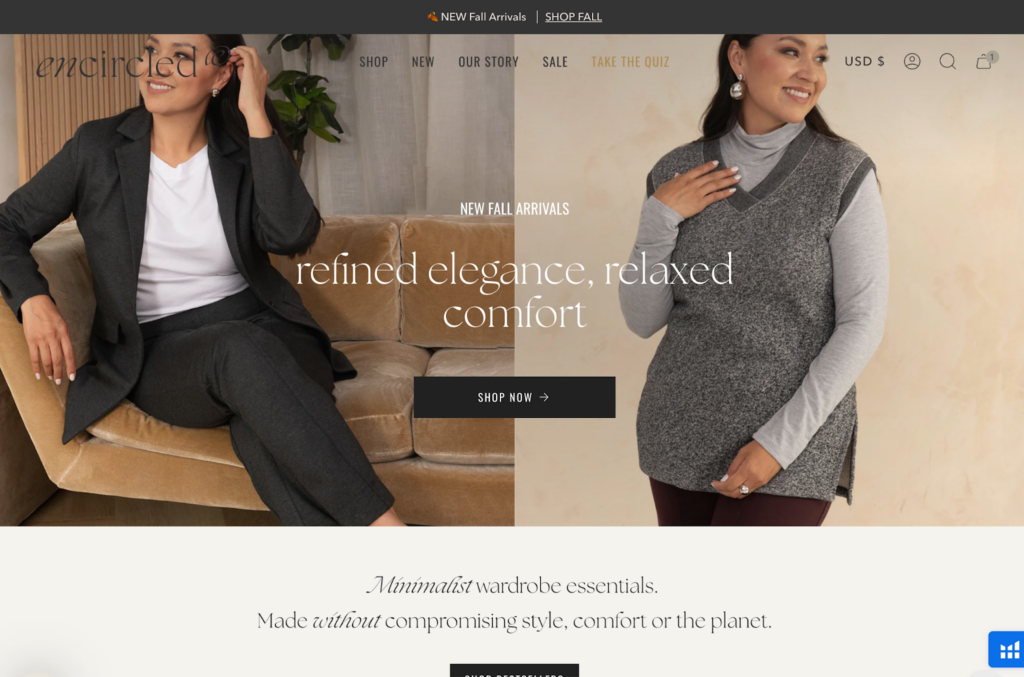
“Ethically made from the finest, most soft and flattering eco-friendly fabrics, our collection is designed with intention, flexibility and exceptional fit at its heart.”
Kristi Soomer, Founder of Encircled /how
🌎
How do they ensure their sustainability?
Encircled prioritizes sustainability through minimizing waste and maximizing options. They are vigilant about closing gaps in the supply chains and the life of each piece of clothing. Their sewing studios upcycle all scrap fabrics into accessories, putting them up for quarterly sales. Encircled Renewed Threads is a platform where you can find pre-loved items. It is also possible to buy, sell, or trade Encircled clothes on their Facebook community page. Other environmental incentives include using green energy to power their office and host their website, FSC-certified and eco-friendly paper and cleaning products, and 100% recyclable packaging. Encircled manufactures their products locally and spends at least 50% of their non-labor expenses at local independent suppliers to reduce their carbon footprint. Lastly, they prioritize natural fabrics, such as organic cotton and linen, and low-impact, plant-based semi-natural fabrics, such as TENCEL™ Lyocell, TENCEL™ Modal, and LENZING™ ECOVERO™.
🌐
How do they ensure their ethics?
Encircled puts ethics at the core of their operations. Their final stage of production is undertaken in Canada, a low-risk country for labor abuse. They uphold each factory in their supply chain to an Ethical Code of Conduct checklist, exceeding what the law requires. Encircled also visits their international suppliers regularly. Lastly, they advocate continuously for diversity and inclusion.
Is Brand part of any giving-back programs?
Encircled is not known to be part of any giving-back programs.
What is their clothing range?
- Best for: womenswear
- Product range: skirts, dresses, pants, jackets, blazers, knitwear, tops, blouses, T-shirts, stockings, tights, jumpsuits, playsuits, accessories, plus-size
- Price range: $$$
- Size range: XS–XXL
Whimsy + Row: Reducing Eco-Footprint With Every Step of the Process
Whimsy + Row was founded in Los Angeles in 2014 by Rachel Temko, driven by a vision of merging sustainability with contemporary fashion. Today, they have established themselves as a prominent brand in the sustainable fashion landscape, renowned for their eco-friendly practices and commitment to ethical manufacturing.
“Growing and being a good company.” Rachel Temko, founder of Whimsy + Row
🌎
How do they ensure their sustainability?
Whimsy + Row prioritizes sustainability by opting for low-impact materials like lyocell, modal, and viscose trademarked by Lenzing, certified organic cotton, linen, and deadstock/upcycled fabrics. Their clothes are made with low-impact dyes and recycled water. Furthermore, they reduce waste through their small-batch production of long-lasting products and efforts to close the loop to reach zero waste. The final stages of manufacturing are done locally to reduce the transportation footprint. They further offset their carbon emission with the Carbon Fund. Whimsy + Row is carbon neutral.
🌐
How do they ensure their ethics?
Whimsy + Row clothing is made within a few miles of their office, enabling weekly factory visits. The brand ensures that fair wages are given and that workers are being treated fairly.
🤝
Are they part of any giving-back programs?
Whimsy + Row actively participates in giving-back programs that support environmental causes and community initiatives. Specifically, they donate money to organizations like One Tree Planted, People Tree, Global Fund for Women, Black Lives Matter, Reclaim the Block, Black Vision Collective, Downtown Women’s Health Center, and Feeding America. Once a month, their employees also donate their time to community work, such as cleaning the beach or planting trees.
🛍️
What is their product range?
- Best for: womenswear with eco-friendly, contemporary designs
- Product range: skirts, denim, dresses, pants, tops, blouses, shorts, lingerie, plus-size
- Price range: $$$
- Size range: XS–3XL
Stella McCartney: Luxurious Fashion Clothes Made Ethically and Sustainably
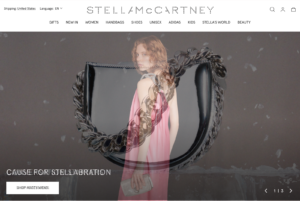
“We are committed to being an ethical, modern and honest company without compromising on luxury or quality.”
Stella McCartney
🌎
How do they ensure their sustainability?
Stella McCartney ensures sustainability by making use of the most cutting-edge and progressive materials that aim to reduce the impact on the planet and are always cruelty-free while following the principles of circularity. They use a medium proportion of eco-friendly and innovative materials, including GOTS-certified organic cotton, cashmere from 100% recycled waste Re.Verso™, and low-impact plant-based alternative materials (BananaTex®, VEGEA, Mylo™, MIRUM®). Further down the life-cycle, Stella McCartney employs technological advances to trace their products, lower their manufacturing impact, and increase their circularity. Additionally, they exclusively use paper that is either FSC-certified or made from at least 50% recycled content in their packaging. In 2014, the brand launched Clevercare—a garment labeling system covering five simple areas of clothing care: washing, temperature, drying, ironing, and dry cleaning to help extend the life of garments, decrease the number of pieces that end up in landfill, and reduce life-cycle environmental footprint.
🌐
How do they ensure their ethics?
Stella McCartney commits to transparency across supply chains through diligent reporting, measuring, and tracking. Stella McCartney is a member of the Ethical Trading Initiative (ETI), a human rights organization driving force in ethical trade. They trace most of their supply chain. Additionally, they commit to protecting the forest and conserving biodiversity by exclusively using viscose, one of the top five most-used materials, from FSC-certified wood pulp and Canopy-approved suppliers.
🤝
Are they part of any giving-back programs?
Stella McCartney partners with and supports many charities, including but not limited to Bioplanet, Million Trees Miami, Naked Heart Foundation, Meat Free Monday, and Sea Shepherd.
🛍️
What is their product range?
- Best for: womenswear, menswear, kidswear
- Product range: shirts, skirts, denim, sweaters, swimwear, dresses, pants, jackets, blazers, hoodies, knitwear, tops, blouses, T-shirts, underwear, socks, shorts, jumpsuits, playsuits, shoes, accessories, plus size
- Price range: $$$
- Size range: XS–3XL
TAMGA Designs: Luxurious, Lightweight, and Forest-Friendly Clothing
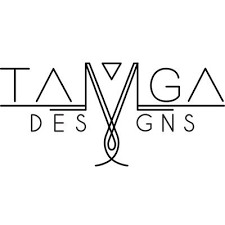
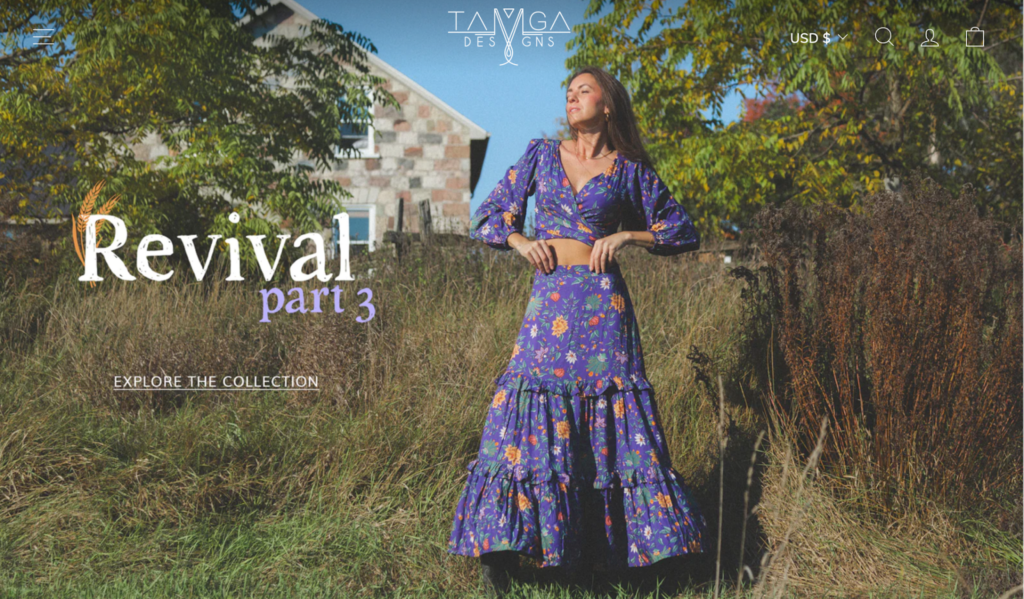
“We believe in a bright future for our planet, which is why we only use fabrics made from traceable and sustainable botanic fibers. ”
TAMGA Designs
🌎
How do they ensure their sustainability?
TAMGA Designs ensures sustainability by lowering their environmental impacts throughout the life-cycles of their clothes. In the material sourcing stage, they use only 100% biodegradable and recyclable fabrics, including low-impact, certified, traceable wood-based fabrics (lyocell, modal, viscose) from Lenzing and European-original linen. To manufacture their colorful collection, TAMGA Designs opts for OEKO-Tex 100 certified dyes that use 70% less water than conventional synthetic dyes. Each finished product is packed in an unbleached GOTS-certified organic cotton tote bag that can be reused for traveling or home storage. Other packing elements are made with recycled, recyclable, or compostable materials. TAMGA Designs also uses the leftover fabric from previous collections to create the “Revival” collection. Lastly, they offset all carbon emissions to make their garments carbon-neutral. In 2022, through their partnership with SimpliZero, TAMGA Designs invested in Gold-Standard offsetting projects, including the Sirap Wind Farm in Indonesia, a Bundled Wind Power project in China, and a Clean Drinking Water project in Cambodia.
🌐
How do they ensure their ethics?
TAMGA Designs ensures their ethics by sharing every supplier that touches a TAMGA garment, from “field to fashion.” Their direct suppliers are upheld to a Code of Conduct that covers all of ILO’s Fundamental Freedoms principles. They visit most of their suppliers regularly.
🤝
Are they part of any giving-back programs?
Since their inception, TAMGA Designs has always given back a portion of their sales to causes they care about. Through their partnership with 1% For the Planet, they give 1% of the annual sales to the Sumatran Orangutan Society (S.O.S.). The fund is used to replant the rainforests in Sumatra, restoring one of the world’s most important biodiversity hotspots and bringing back the habitat for four critically endangered species, including orangutans, rhinos, elephants, and tigers. Additionally, they have a special t-shirt collection made with Lenzing’s viscose fabrics, Trees Please Tee, for which they contribute $10 per every sold item to S.O.S. In 2022, they celebrated Forest-Friendly-Friday and International Orangutan Day, donating 20% and 25% of all sales, respectively, to the Sumatran Orangutan Society.
🛍️
What is their product range?
- Best for: womenswear, kidswear
- Product range: skirts, shirts, dresses, pants, tops, blouses, shorts, jumpsuits, playsuits, T-shirts, kimonos, loungewear, accessories, plus size
- Price range: $$$$
- Size range: XS–XXL
Ecoalf: Committing to Recycling Waste and Cleaning the Environment

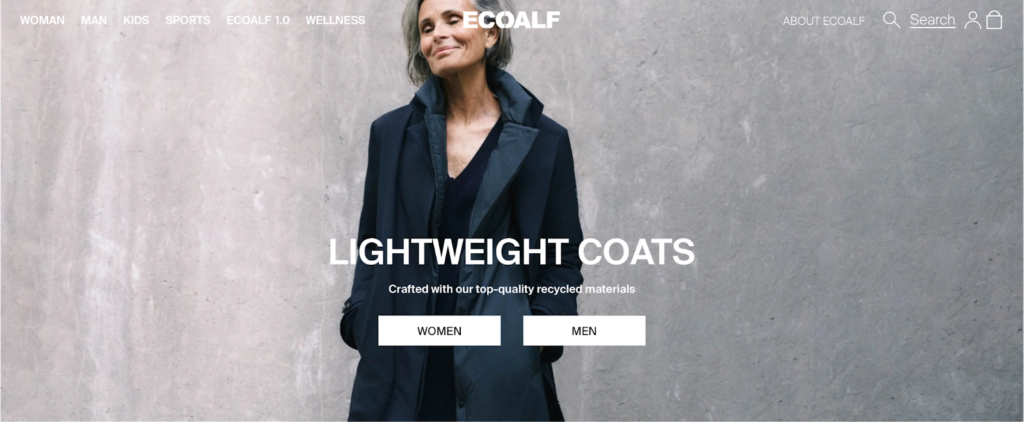
“I believe the time when fashion was just about looking good is over. More than ever it has to be about doing what is right and feeling good about it.”
Javier Goyeneche, founder of Ecoalf
🌎
How do they ensure their sustainability?
Ecoalf’s commitment to sustainability is evident in their innovative recycling practices. They minimize the use of natural resources by using mainly waste as raw materials, collecting and transforming discarded materials such as plastic bottles, discarded fishing nets, and post-industrial cotton into high-quality fashion items. In 2023, they launched their first 100% recycled cotton collection that can be recycled again to achieve circularity. In 2021, 74% of the materials used by Ecoalf were recovered from waste, saving 1,377 tons of CO₂. In combination with recycled fabrics, including mechanically recycled cotton, recycled wool, recycled polyester, and recycled nylon, Ecoalf also sources some low-impact materials, such as natural fabrics (linen, hemp, kapok) and semi-natural fabrics, including ECOVERO™ viscose. Ecoalf is also Bluesign® and B Corporation certified.
🌐
How do they ensure their ethics?
Ecoalf ensures their ethics by protecting their workers and the environment. In particular, they ensure there are safe and fair working conditions in their supply chain by mandating a Code of Conduct, an Equality Scheme, a Crime Prevention Handbook, a Disciplinary System, and a Bullying at Work Protocol. Additionally, they run many campaigns to raise awareness of the state of our ocean and earth-damaging consumerism habits.
🤝
Are they part of any giving-back programs?
Ecoalf actively participates in giving-back programs. The Ecoalf Foundation was founded to clean the oceans of marine waste with the help of the fishing industry while giving a second life to plastic waste through recycling and closing the loop. They achieve that with their “Upcycling the Oceans” projects. In 2021, Ecoalf donated 10% of all Because There’s No Planet B sales to the Ecoalf Foundation to expand the “Upcycling the Oceans” project beyond the Spanish border and into countries like Thailand, Greece, and France. The foundation also partners with Biotherm to set up the framework of “Limpia ríos, salva océanos”, a project supported by corporate volunteer days to collect waste and restore the environment. Additionally, Ecoalf’s employees volunteer in various environmental incentives.
🛍️
What is their product range?
- Best for: womenswear, menswear, kidswear
- Product range: shirts, pants, jackets, blazers, hoodies, sweatshirts, tops, blouses, knitwear, T-shirts, sneakers, accessories
- Price range: $$
- Size range: XS–XL
LANIUS: Premium-Quality Womenswear Advocating for Slow Fashion

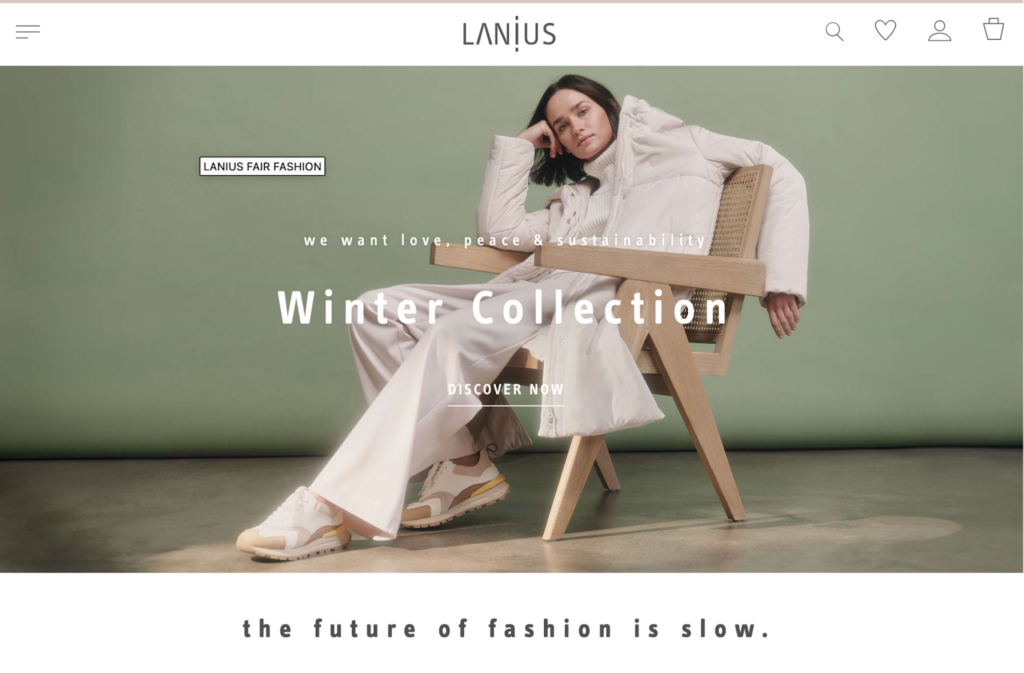
“For our textiles we use a whole variety of renewable raw materials, free of pesticides, herbicides and other poisons. ”
LANIUS
🌎
How do they ensure their sustainability?
LANIUS prioritizes sustainability by opting for a high proportion of eco-friendly materials, lowering their carbon footprint, and reducing waste by reusing some of their offcuts. They mainly use organic materials from controlled organic cultivation or from controlled organic animal husbandry, including GOTS-and OCS-certified organic cotton, hemp, linen, and mulesing-free wool. LANIUS also works with resource-saving semi-natural fabrics, such as TENCELTM fibers and ECOVERO™ viscose from Lenzing. Further down the life-cycle in the manufacturing stage, LANIUS uses low impact non-toxic dyes in most of their products while avoiding chemical high-grade finishing, such as anti-moth finishes, chlorine bleach or biocide finishes, resin, nickel, and Teflon. Regarding their carbon footprint, the brand implements various reduction measures like shortening the value chains to avoid unnecessary transport routes, using renewable energy in their supply chain, and shipping products in recycled cardboard boxes that are often reused several times. The unavoidable emissions are offset by reforestation and renewable energy projects in Asia. Lastly, as their dedication to slow fashion, LANIUS strives to extend the life of the clothes you and other consumers already own with their Care – Repair – Resell – Rent platform.
🌐
How do they ensure their ethics?
LANIUS traces most of their supply chain and discloses factories where their various finished products are manufactured. Their production partners have sustainability certificates such as the GOTS certificate, the BSCI Code of Conduct, and the SA8000 standard, and are audited by the Fair Wear Foundation. Additionally, LANIUS regularly visits their partners.
🤝
Are they part of any giving-back programs?
LANIUS is not known to be part of any giving-back programs.
🛍️
What is their product range?
- Best for: womenswear
- Product range: shirts, denim, sweaters, pants, hoodies, tops, blouses, T-shirts
- Price range: $$
- Size range: S–XL
COSSAC: Timeless, Feminine, and Versatile Apparel

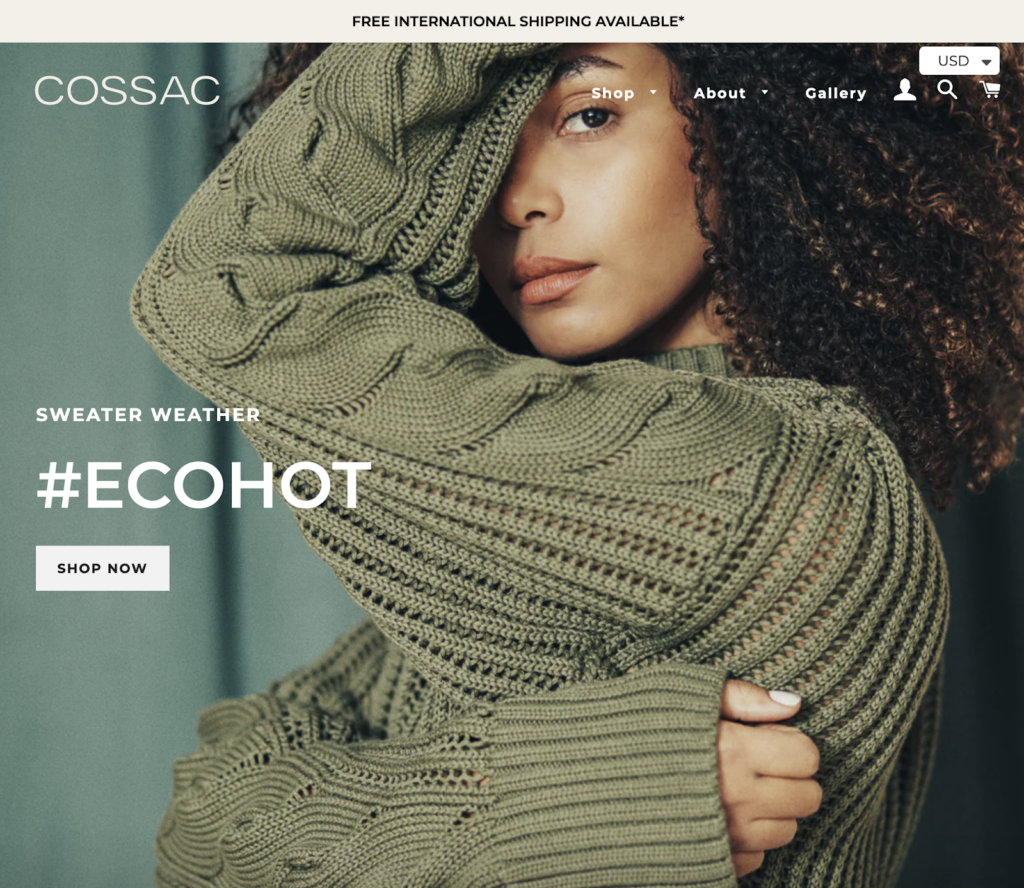
“We make it our purpose to keep COSSAC pieces in circulation and extend the enjoyment of our garments by opening access to our archive for exclusive sales and participating in rental initiatives to further reduce waste.”
COSSAC
🌎
How do they ensure their sustainability?
COSSAC promotes sustainability by sourcing a medium proportion of eco-friendly materials sourced and manufactured in the EU. Their core fabrics include organic cotton, organic wool, and Lenzing’s lyocell, modal, and viscose. Additionally, COSSAC makes use of recycled fibers, including recycled polyester, recycled wool, and cupro regenerated from cotton waste, for their garments and recycled paper for their business cards, swing tags, and boxes. Further down the life-cycle in manufacturing, they lower their environmental impacts by minimizing textile waste with small production runs and reducing carbon footprint with renewable energy in their supply chain. Lastly, COSSAC offers carbon-neutral shipping powered by Cloverly.
🌐
How do they ensure their ethics?
COSSAC traces most of their supply chain and visits their suppliers regularly. They publish the factories taking care of their final stage of production, which takes place in Portugal.
🤝
Are they part of any giving-back programs?
COSSAC partners with Ecologi to replant mangrove forests with very high carbon sequestration potential. They plant one tree for each purchase made on their website.
🛍️
What is their product range?
- Best for: menswear, womenswear, kidswear
- Product range: sweaters, dresses, pants, jackets, blazers, shorts, hoodies, T-shirts, tops, blouses, maternity wear, stockings, tights, jumpsuits, playsuits, sportswear, sleepwear, accessories, plus size
- Price range: $$
- Size range: XS–XXL
Amour Vert: Stylish and Environmentally Friendly Clothing Made in the US

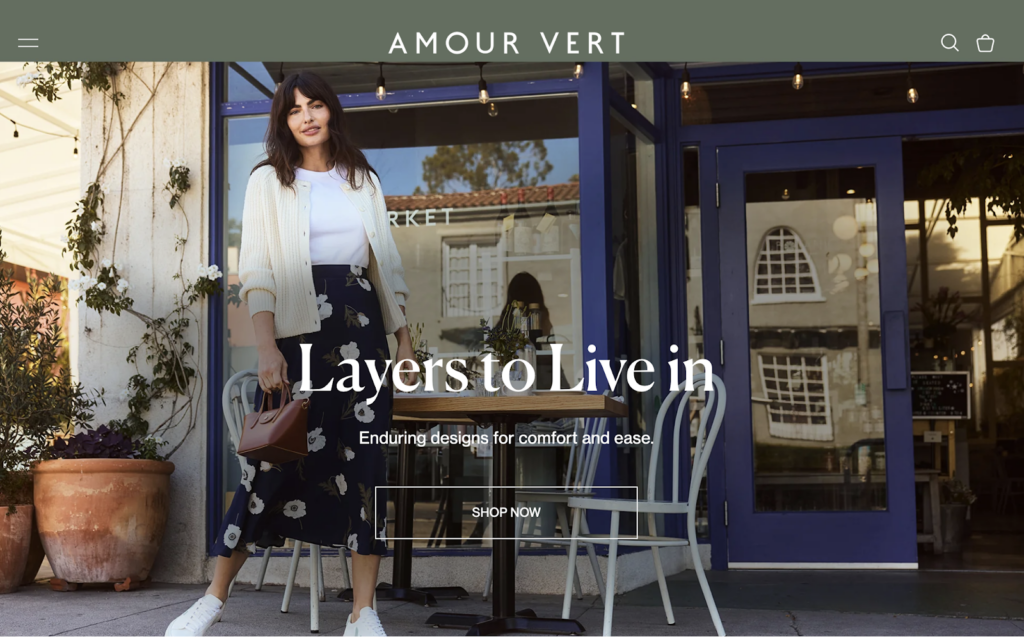
“Our sustainable practices address all aspects of our business operations and the full lifecycle of the garment: the fibers and production processes used, how workers are treated, how it gets to the consumer, and finally—whether it can be recycled or is forced into a landfill.”
Amount Vert
🌎
How do they ensure their sustainability?
Amour Vert ensures sustainability by using traceable, eco-friendly materials and promoting circular fashion. They use a medium proportion of lower-impact fibers, including organic cotton, linen, and Lenzing’s lyocell, modal, and viscose. Additionally, they opt for recycled varieties of higher-impact fabrics, such as polyester and cashmere, to reduce their carbon footprint. The silk used in Amount Vert’s collection is Bluesign® certified. Regarding circular fashion initiatives, Amour Vert uses deadstock fabric and sells pre-loved clothing through their resale marketplace, ReAmour.
🌐
How do they ensure their ethics?
Amour Vert traces part of their supply chain, including suppliers in the final stage of production, which happens in the US.
🤝
Are they part of any giving-back programs?
Amour Vert partners with American Forests® to plant trees in North America: with every purchase of a tee, they plant a tree.
🛍️
What is their product range?
- Best for: womenswear
- Product range: shirts, denim, sweaters, dresses, pants, tops, blouses, T-shirts
- Price range: $$
- Size range: XS–XXL
ELK: Clothing Brand Promoting Sustainability and Transparency
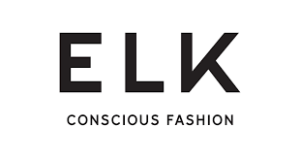
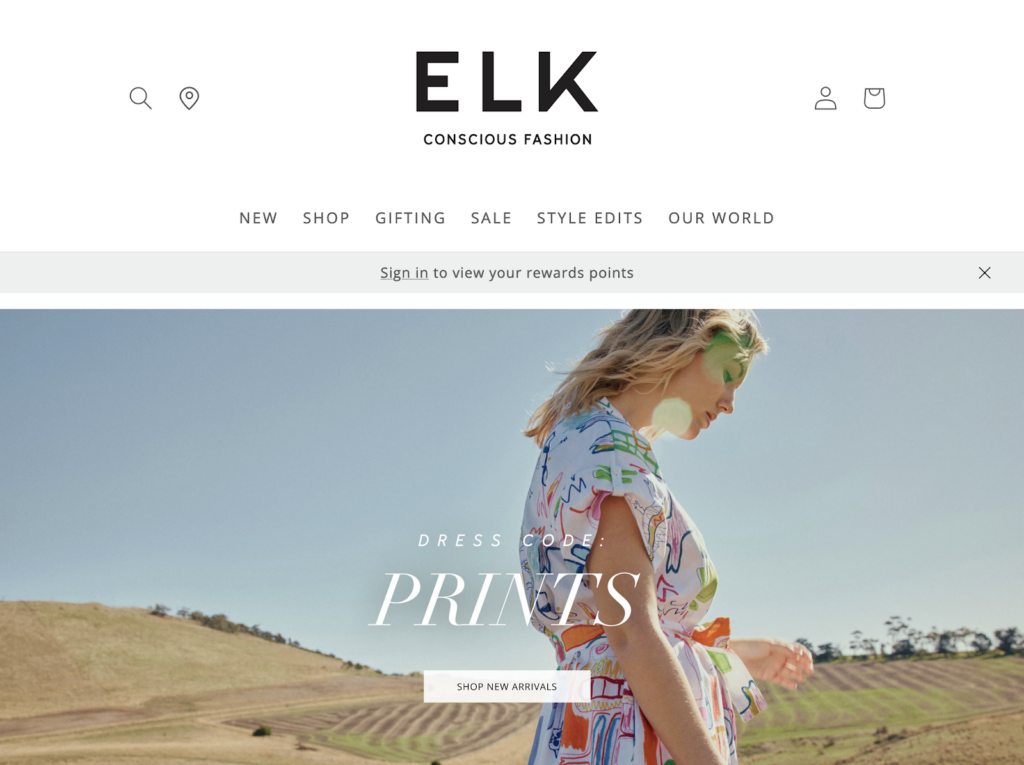
“With a focus on natural or lower impact materials the business continues to seek better alternatives for fibres, production, distribution, circular solutions and waste.”
ELK
🌎
How do they ensure their sustainability?
ELK ensures sustainability by increasing the proportion of preferred materials, reducing their absolute carbon emissions, minimizing manufacturing waste, and promoting circularity in fashion with their Care & Repair guide. They prioritize low-impact materials that are either recycled from waste or obtained from renewable, responsibly grown, harvested, and processed fibers. These include GOTS-certified organic cotton, recycled natural and synthetic fibers, and traceable forest fibers like ECOVERO™. In 2023, their collections were made with 64% of ELK Environmentally Preferred Fibers and Materials, up from 45% in 2022. In addition to textiles, they have also been transitioning into more eco-friendly packaging and printed materials with an increasing amount of recycled content. Furthermore, they implement various carbon reduction initiatives, such as using 100% renewable electricity for ELK’s direct operations, of which 47% are self-generated from onsite solar panels, installing energy-efficient LED lighting across their buildings, and transporting in bulk using sea freight. Lastly, they strive to minimize operational waste. In 2023, 94% of their operational waste was recycled. They have dedicated recycling bins for paper, soft plastics, organic waste, and mixed recycling to ensure that waste is disposed of in the right place. Particularly, their HQ has worm farms to compost food waste, including their coffee grounds and tea bags.
🌐
How do they ensure their ethics?
ELK ensures their ethics by publishing annual transparency reports highlighting their ethical and environmental journey. Their facilities are audited and reported through Sedex Members Ethical Trade Audit – SMETA Best Practice Guidance. Additionally, ELK upholds their suppliers to a Code of Conduct covering all of ILO’s Fundamental Freedoms principles. They trace most of their supply chain.
🤝
Are they part of any giving-back programs?
ELK is a member of 1% for the Planet, committing to donate 1% of all sales to environmental protection, empowering women, and supporting local communities. ELK also has an ongoing partnership with TreeProject, through which they have donated $2 for every online order and planted more than 135,000 native seedlings since 2020. In 2023, they donated $10,000 to the Karrkad Kanjdji Trust, owned and led by First Nations people of Australia. They also completed 333 hours of volunteering in the same year.
🛍️
What is their product range?
- Best for: womenswear
- Product range: dresses, tops, shirts, skirts, shorts, knitwear, jumpsuits, jackets, jeans, pants, accessories, plus size
- Price range: $$$
- Size range: XS–XL
Viscose Fabrics: Breathable and Biodegradable Plant Material
Viscose fabrics are semi-natural/semi-synthetic fabrics made with plant materials. LENZINGTM ECOVERO™ is a sustainable viscose made in a closed-loop process where chemicals are recovered and reused.
Here are the life-cycle stages of viscose fabrics and each stage’s sustainability assessment:
- Sourcing of viscose fabrics: The sourcing stage is generally sustainable because viscose fabrics are made from renewable wood or wood-like materials. The most common cellulose fibers in viscose manufacturing come from fast-growing trees and plants like eucalyptus, bamboo, or soy. However, there are concerns over the association between sourcing raw materials for viscose fabrics and deforestation in ancient and endangered forests.
- Manufacturing of viscose fabrics: Manufacturing viscose fabric is energy and chemical-intensive, which could have serious knock-on ecological impacts, especially if fossil fuels are the main energy sources at the manufacturing locations. However, integrated manufacturing processes can recover part of the energy during production while optimizing materials. In this case, manufacturing viscose fabrics can be designed to be more sustainable. Alternatively, using upcycled viscose is sustainable as it bypasses the high-impact manufacturing process.
- Transportation of viscose fabrics: Transporting can be a carbon-intensive stage in the life-cycle of clothing items made with viscose fabrics due to the distances covered and emissions associated with transporting vehicles. Virgin viscose fabrics typically travel from forests, where raw materials for viscose are grown, to processing and finishing factories, sorting centers, shops, and consumers’ homes before going to recycling centers or landfills.
- Usage of viscose fabrics: The usage of viscose fabrics is generally not very sustainable because viscose clothing lacks durability.
- End-of-life of viscose fabrics: The end-of-life stage for viscose fabric is generally sustainable because it is reusable, biodegradable, and compostable.
Viscose is the first generation of regenerated fiber rayon, made with natural cellulose fibers, and, thus, is fully biodegradable at the end of its life-cycle. The high chemical and energy usage makes viscose less sustainable than the later generations of rayon (modal and lyocell).
Why Is It Important to Buy Products Made of More Sustainable Fabrics
It is important to buy products made of more sustainable fabrics because a sustainable textile industry has a lower carbon footprint, helps save natural resources, and is better for forests, animals, and humans.
Buying Sustainable Fabrics Reduces Your Carbon Footprint
The production of clothing and footwear is estimated to contribute 10% of global greenhouse gas emissions—more than all international flights and shipping combined. If the fashion industry were a country, it would be the fourth largest emitter of carbon dioxide.
One way to reduce the carbon footprint of the clothes you buy is to opt for sustainable fabrics. Sustainable fabrics, which are often made with natural or recycled fibers, have relatively low carbon footprints compared to petroleum-based fabrics. For example, organic cotton made in the US has a carbon footprint of 2.35 kg CO2 (per ton of spun fiber)—a quarter of polyester’s carbon footprint.
Buying Sustainable Fabrics Reduces Demand For Natural Resources and Waste Management
The textile industry uses water and land to grow cotton and other fibers. It is estimated that 79 billion cubic meters of water were used for the sector worldwide in 2015. For example, producing a single cotton t-shirt requires as much water as one person drinks for 2.5 years (2,700 liters of fresh water).
Worse yet, the textile economy is vastly more linear than circular: the largest amount of resources used in clothes ended up in landfills (instead of being recycled to remake clothes). According to a report by the Ellen MacArthur Foundation,
- Less than 3% of materials used in the textile economy in 2015 came from recycled sources.
- In other words, more than 97% of resources used in making clothes are newly extracted.
When clothing items are disposed of within a short period of time—under a year in the case of half of the fast fashion clothes—the natural systems that provide raw materials for fabrics don’t have enough time to recover and regenerate, which could lead to ecological breakdown.
Sustainable fabrics are made with less water and emissions while lasting longer:
- Because they are durable, you don’t need to buy new clothes too often.
- Thus, you help reduce the pressure to extract more resources for making new items.
Similarly, making and consuming sustainable fabrics made with recycled materials reduces the demand for virgin materials while helping tackle waste management.
Buying Sustainable Fabrics Encourages Sustainable Management of Forests
Sustainable plant-based fabrics are made with raw materials from forests and plantations that are sustainably managed, such as complying with FSC standards.
When you buy sustainable plant-based fabrics, you discourage unsustainable forestry practices like illegal logging. You can help reduce deforestation, biodiversity loss, and the effects of climate change.
Buying Sustainable Fabrics Encourages Fairer Treatment of Animals
The fashion industry is rife with animal mistreatment when it comes to making animal-based fabrics like wool or silk. Every year, billions of animals suffer and die for clothing and accessories.
Buying sustainable vegan alternatives can help to reduce the pressure on raising more and more animals to meet the demand for animal-based fabrics while sacrificing their well-being and lives.
Suppose you have to buy fabrics made with, for example, wool or silk; make sure you only choose brands committed to cruelty-free products. In that case, you help advocate better treatments for animals raised within the textile industry.
Using Sustainable Fabrics Encourages Fairer Treatment of Textile Workers
Recent statistics from UNICEF estimated as many as 170 million child laborers worldwide, many of whom were engaged in some form of work in the textile industry. They don’t get paid minimum wages and often work long hours.
When you buy sustainable fabrics from brands transparent about the working conditions at their factories, you discourage the use of child labor and help promote better working conditions for textile workers.
How Can You Generally Buy More Sustainable Fabrics
The key to sustainably buying fabrics is to check on relevant environmental and original certifications.
For natural fabrics:
- Global Organic Textile Standard (GOTS): A globally recognized certification system that ensures a certain threshold of organic content has been met. It covers manufacturing, packaging, labeling, transportation, and distribution (but not what happens in the fields where crops are grown).
- USDA Certified Biobased Product: The USDA BioPreferred® Certification is a voluntary certification offered by the United States Department of Agriculture. The certification identifies products made from plants or other renewable materials.
- Ecolabel: Ecolabel is the official European Union voluntary label recognized worldwide for certified products with a guaranteed, independently verified low environmental impact. The label requires high environmental standards throughout the entire life-cycle: from raw material extraction through production and distribution to disposal. It also encourages companies to develop innovative, durable, easy-to-repair, and recyclable products.
For plant-based semi-natural/semi-synthetic fabrics:
- Forest Stewardship Council: An FSC certification ensures that the wood (or wood-like material) comes from responsibly managed forests that provide environmental, social, and economic benefits.
There are two types of FSC Certification:- FSC Forest Management Certification, with a focus on the origin of the wood—the forest.
- FSC Chain of Custody Certification, which focuses on the path from the forest to the customer’s home.
- Program for Endorsement of Forest Certification: PEFC’s approaches to sustainable forest management are in line with protecting the forests globally and locally and making the certificate work for everyone. Getting a PEFC certification is strict enough to ensure the sustainable management of a forest is socially just, ecologically sound, and economically viable but attainable not only by big but small forest owners.
For recycled fabrics:
- Recycled Claim Standard (RCS): The Textile Exchange RCS was originally developed as an international, voluntary standard that sets requirements for third-party certification of Recycled input and chain of custody.
- The Global Recycled Standard (GRS): The Global Recycled Standard (GRS) is an international, voluntary, full product standard that sets requirements for third-party certification of Recycled Content, chain of custody, social and environmental practices, and chemical restrictions. It can be used for any product with more than 20% recycled material.
For all types of fabrics:
- STeP by OEKO-TEX®: STeP by OEKO-TEX® is an independent certification system for brands, retailers, and manufacturers from the textile and leather industry. It communicates organizational environmental measures, including reducing carbon footprint and water usage.
- OEKO-TEX® Standard 100: OEKO-TEX® labels aim to ensure that products pose no risk to human health (i.e., containing banned chemicals).
Some certifications that are signaling brands’ efforts toward lowered environmental impacts and a circular economy are:
- B Corp Certification: The label B Corp is a certification reserved for for-profit companies. Certified holders are assessed on their social and environmental impacts.
- Cradle2Cradle certification: Cradle2Cradle provides a standardized approach to material circularity. It assesses whether products have been suitably designed and made with the circular economy in mind covering five critical categories: material health, material reuse, renewable energy and carbon management, water stewardship, and social fairness.
Final Thoughts
Conventional viscose is considered unsustainable because of the harmful chemicals used during manufacturing. However, viscose fabrics produced in closed-loop systems that recycle and reuse chemicals and water and use traceable cellulose fibers, such as ECOVERO™, have relatively low environmental impacts. Alternatively, upcycled viscose is sustainable, thanks to bypassing the manufacturing process.
By purchasing new or pre-loved viscose clothes from brands that commit to sustainability, you support their mission to create a fairer and less harmful textile industry for all lives on Earth.
Here is the list (again) of the most sustainable viscose clothing brands:
- Altar
- ARMEDANGELS
- Baukjen
- TWOTHIRDS
- Encircled
- Whimsy + Row
- Stella McCartney
- TAMGA Designs
- Ecoalf
- LANIUS
- COSSAC
- Amour Vert
- ELK
To make your use of these fabrics even more sustainable, follow these steps:
- Buy second-hand, recycled, or upcycled clothes made with viscose fabrics.
- While using viscose clothes, maximize the number of wears between washes and keep them as long as possible.
- At the end-of-life of your viscose clothes, upcycle the materials to extend their usage and arrange for them to be recycled or properly disposed of.
Stay impactful,

Sources
- Impactful Ninja: How Sustainable Are Viscose Fabrics? A Life-Cycle Analysis
- Impactful Ninja: How Sustainable Are Rayon Fabrics? A Life-Cycle Analysis
- Science Direct: Sustainable Fibres and Textiles
- Science Direct: Life-cycle assessment (LCA)
- Lenzing: What is Viscose fiber?
- Lenzing: Chemicals | Closing the loops
- Altar: Home
- ARMEDANGELS: Home
- Baukjen: Home
- TWOTHIRDS: Home
- Encircled: Home
- Whimsy + Row: Home
- Stella McCartney: Home
- TAMGA Designs: Home
- Ecoalf: Home
- LANIUS: Home
- COSSAC: Home
- Amour Vert: Home
- ELK: Home
- Altar: Mission Statement and Bio
- Impactful Ninja: How Sustainable Are Lyocell Fabrics? A Life-Cycle Analysis
- Impactful Ninja: How Sustainable Are Modal Fabrics? A Life-Cycle Analysis
- Altar: Talking Trash!
- Altar: Altar Pre-Loved
- Impactful Ninja: How Sustainable Are Synthetic Fabrics? A Life-Cycle Analysis
- ReTold Recycling: Home
- Noissue: Home
- Packwire: Home
- Papermart: Home
- Treet: Home
- Recovo: Home
- Good On You: Brand Directory | Altar
- Greenspark: Home
- Black Lives Matter: Home
- Reclaim the Block: Home
- Don’t Shoot PDX: Home
- Palestine Children’s Relief Fund: Home
- Good On You: Brand Directory | ARMEDANGELS
- ARMEDANGELS: THE JOURNEY FROM RAW MATERIAL TO PRODUCT | A T-shirt made from Organic Cotton
- Impactful Ninja: How Sustainable Are Organic Cotton Fabrics? A Life-Cycle Analysis
- Textile Exchange: Global Recycling Standard
- Impactful Ninja: How Sustainable Are Recycled Fabrics? A Life-Cycle Analysis
- Global Organic Textile Standard (GOTS): Home
- Impactful Ninja: How Sustainable Are Organic Wool Fabrics? A Life-Cycle Analysis
- Forest Stewardship Council: Home
- Programme for the Endorsement of Forest Certification: Home
- ARMEDANGELS: THE JOURNEY FROM RAW MATERIAL TO PRODUCT | Cellulose
- ARMEDANGELS: THE JOURNEY FROM RAW MATERIAL TO PRODUCT | Recycling
- ARMEDANGELS: About Us
- Impactful Ninja: How Sustainable Are Wood-Based Fabrics? A Life-Cycle Analysis
- Impactful Ninja: How Sustainable Are Silk Fabrics? A Life-Cycle Analysis
- Impactful Ninja: How Sustainable Are Natural Fabrics? A Life-Cycle Analysis
- Impactful Ninja: How Sustainable Are Recycled Wool Fabrics? A Life-Cycle Analysis
- Impactful Ninja: How Sustainable Are Recycled Cotton Fabrics? A Life-Cycle Analysis
- ARMEDANGELS: DETOX DENIM
- ARMEDANGELS: Care Guide
- ARMEDANGELS: Repair Guide
- ARMEDANGELS: RETURN YOUR OLD CLOTHES | RECYCLING WITH BENEFITS
- ARMEDANGELS: ACTION REPORT 2021
- Fair Wear Foundation: Home
- ARMEDANGELS: LIVING WAGE PROJECT
- ARMEDANGELS: Collaborations
- Doctors Without Borders: Home
- German Zero: Home
- Climate Emergency Fund: Home
- Sea-Watch: Home
- B Corporation: House of Baukjen
- Baukjen: Our Fabrics
- Baukjen: Ecotec recycled cotton
- Baukjen: Recycled wool
- Baukjen: Recycled cashmere
- Baukjen: Newlife recycled polyester
- Baukjen: Recycled down
- Baukjen: Sustainable Impact Report Quarter 2 2023
- Baukjen: Impact Report 2022
- Baukjen: Ecojilin viscose
- Canopy Planet: Hot Button Report
- Baukjen: Pre-Loved Collection
- Baukjen: Women’s Clothing Rental
- Baukjen: Wear, Care & Repair
- Baukjen: Factories
- Good On You: Brand Directory | Baukjen:
- International Labour Organization: Home
- International Labour Organization: ILO Declaration on Fundamental Principles and Rights at Work
- Baukjen: Sustainable Attributes
- Baukjen: We are Baukjen
- NHS Charities Together: Home
- World Land Trust: Home
- Baukjen: Philanthropy
- Smart Works: Home
- B Corporation: TWOTHIRDS
- TWOTHIRDS: We Are Eco
- Impactful Ninja: How Sustainable Are Linen Fabrics? A Life-Cycle Analysis
- Impactful Ninja: How Sustainable Are Hemp Fabrics? A Life-Cycle Analysis
- TENCEL: TENCELTM Lyocell
- Good On You: Brand Directory | TWOTHIRDS
- TWOTHIRDS: Why You’ll Never Catch Us Using Viscose (With One Important Exception)
- TWOTHIRDS: Find out more about TWOTHIRDS
- Impactful Ninja: How Sustainable Are Wool Fabrics? A Life-Cycle Analysis
- Good On You: Meet Ocean-Inspired Sustainable Brand TWOTHIRDS
- TWOTHIRDS: Into the Blue
- WWF Spain: Home
- B Corporation: Encircled
- Encircled: Our Promise
- Encircled: Encircled Renewed Threads
- Good On You: Brand Directory | Encircled
- Encircled: Where It’s Made
- Impactful Ninja: How Sustainable Are Semi-Natural/ Semi-Synthetic Fabrics Fabrics? A Life-Cycle Analysis
- TENCEL: TENCEL™ Modal
- Encircled: Encircled Supplier Ethical Practices
- Our Forest: Can you shop at Encircles sustainably
- Whimsy + Row: ABOUT OUR FABRIC
- Whimsy + Row: OUR VALUES & SUSTAINABILITY
- Good On You: Brand Directory | Whimsy + Row
- Whimsy + Row: OUR STORY
- Carbon Fund: Home
- One Tree Planted: Home
- Black Lives Matter: Home
- Feeding America: HomeStella McCartney: Sustainability
- Stella McCartney: Circularity
- Good On You: Brand Directory | Stella McCartney
- Global Organic Textile Standard (GOTS): Home
- Stella McCartney: Organic cotton
- Stella McCartney: Recycled cashmere
- Stella McCartney: BananaTex®
- Stella McCartney: VEGEA
- Stella McCartney: Mylo™
- Stella McCartney: MIRUM®
- Stella McCartney: Traceability and Blockchain Technology
- Stella McCartney: Metals
- Stella McCartney: Spotlight on Airslide
- Stella McCartney: Paper and Packaging
- Stella McCartney: Clevercare
- Stella McCartney: Measuring our impact
- Ethical Trading Initiative: Home
- Stella McCartney: Fibers From Forests
- Stella McCartney: Charities
- Million Trees Miami: Home
- Naked Heart Foundation: Home
- Meat Free Monday: Home
- Sea Shepherd: Home
- TAMGA Designs: Fabrics & Dyes
- TAMGA Designs: 2022 Impact Report
- TAMGA Designs: Revival
- TAMGA Designs: Our Impact
- Good On You: Brand Directory | TAMGA Designs
- 1% For the Planet: Home
- TAMGA Designs: Giving Back | Replanting the Rainforest
- Ecoalf: Materials
- Ecoalf: History
- Ecoalf: DON’T THINK IT’S A UTOPIA | DISCOVER OUR 2021 SUSTAINABILITY REPORT
- Impactful Ninja: How Sustainable Are Recycled Wool Fabrics? A Life-Cycle Analysis
- Impactful Ninja: How Sustainable Are Recycled Polyester Fabrics? A Life-Cycle Analysis
- Impactful Ninja: How Sustainable Are Recycled Nylon Fabrics? A Life-Cycle Analysis
- Impactful Ninja: How Sustainable Are Natural Fabrics? A Life-Cycle Analysis
- Impactful Ninja: How Sustainable Are Kapok Fabrics? A Life-Cycle Analysis
- Bluesign®: Home
- B Corporation: Ecoalf
- Ecoalf: Sustainable Report 2021 | DON’T THINK IT’S A UTOPIA
- Ecoalf: ECOALF foundation
- Ecoalf: Upcycling the Oceans
- Ecoalf: Because There’s No Planet B
- Ecoalf: Personas
- Good On You: Brand Directory | LANIUS
- LANIUS: Our Standards | Sustainability at every level
- LANIUS: Cotton
- LANIUS: Hemp
- LANIUS: Linen
- LANIUS: Merino wool
- LANIUS: TENCELTM
- LANIUS: LENZINGTM ECOVERO™
- LANIUS: CO₂ Compensation
- Climate Partner: 7017
- LANIUS: Care – Repair – Resell – Rent
- LANIUS: Fair Production
- AMFORI: BSCI
- Good On You: Brand Directory | COSSAC
- COSSAC: Sustainable Materials & Fabrics
- Impactful Ninja: How Sustainable Are Organic Wool Fabrics? A Life-Cycle Analysis
- Impactful Ninja: How Sustainable Are Cupro Fabrics? A Life-Cycle Analysis
- COSSAC: Sustainability Report
- Cloverly: Home
- COSSAC: Factories and Suppliers
- Ecologi: Home
- IOP SCIENCE: Estimating mangrove aboveground biomass from airborne LiDAR data: a case study from the Zambezi River delta
- Good On You: Brand Directory | Amount Vert
- Impactful Ninja: How Sustainable Are Polyester Fabrics? A Life-Cycle Analysis
- Amount Vert: Our Signature Fabrics
- Amount Vert: ReAmour
- American Forests® : Home
- Amount Vert: Buy a tee, plant a tree
- ELK: TRANSPARENCY REPORT 2019 | A CONSCIOUS DESIGN JOURNEY
- ELK: ELK Transparency Report
- ELK: Care & Repair Guide
- ELK: Materials
- ELK: Initiatives
- SEDEX: SMETA Best Practice Guidance
- Good On You: Brand Directory | ELK
- ELK: 1% FOR THE PLANET
- European Parliament: The impact of textile production and waste on the environment (infographic)
- Science Direct: The challenge of “Depeche Mode” in the fashion industry – Does the industry have the capacity to become sustainable through circular economic principles, a scoping review
- Science Direct: Carbon Footprint of Textile and Clothing Products
- European Parliament: Environmental impact of the textile and clothing industry
- European Parliament: What if fashion were good for the planet?
- Ellen MacArthur Foundation: A New Textiles Economy: Redesigning fashion’s future
- McKinsey: Style that’s sustainable: A new fast-fashion formula
- Forest Stewardship Council: Home
- Our World in Data: Deforestation and Forest Loss
- Our World in Data: Renewable Energy
- Peta: Animals Used For Clothing
- The Guardian: Child labour in the fashion supply chain
- BioPreferred: WHAT IS THE BIOPREFERRED PROGRAM?
- European Commission: Environment | EU Ecolabel
- Forest Stewardship Council: Home
- FSC Forest Management Certification
- FSC Chain of Custody Certification
- Textile Exchange: The RCS and GRS are designed to boost the use of recycled materials
- OEKO-TEX: OEKO-TEX® Standard 100
- OEKO-TEX: Certification according to STeP by OEKO-TEX®
- B Corp Certification: Home
- C2CCertified: Home
